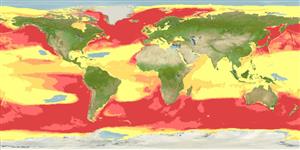Mammalia |
Cetartiodactyla |
Balaenopteridae
Environment: milieu / climate zone / গভীরতার পরিসীমা / distribution range
বাস্তুসংস্থান
ভাসমান; মহাসাগরে বিচরনক্ষম (সূত্র 75906); গভীরতার পরিসীমা 0 - 230 m (সূত্র 1005). Tropical; 90°N - 90°S, 180°W - 180°E
Circumglobal except the Arctic: Balaenoptera physalus physalus: Svalbard, Barents Sea, North Carolina, Portugal, Cantabrian Sea, Newfoundland, Gulf of Mexico, Greater Antilles, Faroe Islands, Norway, Canary Islands, Sea of Okhotsk, Kuril Islands, Bering Sea, Chukchi Sea, Gulf of Alaska, Sea of Japan, Japan, Taiwan, Ogasawara, Hawaii, California, Baja California, Gulf of California; Balaenoptera physalus quoyi: Ross Ice Shelf, Brazil, Gabon, Angola, Namibia, South Africa, Madagascar, Western Australia, New Zealand, Colombia, Peru, Chile (Ref. 1522).
Length at first maturity / আকৃতি / Weight / Age
পরিপক্কতা : Lm ? range ? - ? cm Max length : 2,700 cm TL পুরুষ/ লিঙ্গ অনিধর্ারিত ; (সূত্র 1394); সবের্াচ্চ প্রকাশিত ওজন : 75.0 t (সূত্র 1394)
The largest of the fin whales. Seen near shore, most commonly where deep water approaches the coast. Feeds on small invertebrates, schooling fishes, and squid. They are active lunge feeders (Ref. 1394). They are preyed upon by great white sharks (Ref. 32140). Following depletion of blue whale stocks, whalers shifted their attention to fin whales. Populations everywhere were substantially reduced. At present the worldwide population does not seem to appear in any immediate danger (Ref. 1394). Minimum depth from Ref. 116169. Seen near shore, most commonly where deep water approaches the coast (Ref. 1394). Commonly in groups of 2 to 7 individuals (Ref. 801). Feeds on small I krill (Ref. 122680), invertebrates, schooling fishes, and squid. They are active lunge feeders (Refs. 1394, 122680).
Life cycle and mating behavior
পরিপক্কতা | প্রজনন | ডিম ছাড়া | Eggs | ডিম্বধারন ক্ষমতা | Larvae
Jefferson, T.A., S. Leatherwood and M.A. Webber 1993 FAO species Identification Guide: Marine Mammals of the World. Rome, FAO. 320 p. + 587 figures. (সূত্র 1394)
IUCN Red List Status
(সূত্র 130435: Version 2025-1)
CITES status (সূত্র 108899)
Threat to humans
Human uses
মৎস্য: বাণিজ্যিক
FAO - মৎস্য: landings, species profile | FishSource | আমাদের চতুর্পাশ্বের সাগর
হাতিয়ার
আরো তথ্য
Physiologyঅম্লজান ব্যবহার
Human RelatedStamps, coins, misc.
ইন্টারনেট সুত্র
Estimates based on models
Preferred temperature
(Ref.
115969): 0.2 - 4.6, mean 1.5 (based on 25596 cells).
স্থিতিস্থাপক
মাধ্যম , সর্বনিম্ন প্রজন দ্বিগুনের সময় ১.৪-৪.৪ বৎসর (K=0.25-0.27; tm=17.5).
Fishing Vulnerability
Very high vulnerability (76 of 100).
Price category
Unknown.
